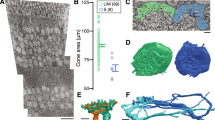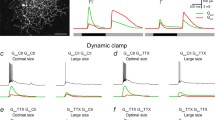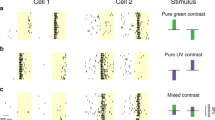Summary
The colour of an object is changed by surround colours so that the perceived colour is shifted in a direction complementary to the surround colour. To investigate the physiological mechanism underlying this phenomenon, we recorded from 260 neurons in the parvo-cellular lateral geniculate nucleus (P-LGN) of anaesthetized monkeys (Macaca fascicularis), and measured their responses to 1.0–2.0° diameter spots of equiluminant light of various spectral composition, centered over their receptive field (spectral response function, SRF). Five classes of colour opponent neurons and two groups of light inhibited cells were distinguished following the classification proposed by Creutzfeldt et al. (1979). In each cell we repeated the SRF measurement while an outer surround (inner diameter 5°, outer diameter 20°) was continuously illuminated with blue (452 nm) or red (664 nm) light of the same luminance as the center spots. The 1.0–1.5° gap between the center and the surround was illuminated with a dim white background light (0.5–1cd/m2). During blue surround illumination, neurons with an excitatory input from S-or M-cones (narrowand wide-band/short-wavelength sensitive cells, NSand WS-cells, respectively) showed a strong attenuation of responses to blue and green center spots, while their maintained discharge rate (MDR) increased. During red surround illumination the on-minus-off-responses of NS- and WS-cells showed a clear increment. L-cone excited WL-cells (wide-band/long-wavelength sensitive) showed a decrement of on-responses to red, yellow and green center spots during red surround illumination and, in the majority, also an increment of MDR. The response attenuation of narrow-band/long-wavelength sensitive (NL)-cellls was more variable, but their on-minus-off-responses were also clearly reduced in the average during red surrounds. Blue surround illumination affected WL-cell responses little and less consistently than those of NL-cells, but often broadened the SRF also in the WL-cells towards shorter wavelengths. The M-cone excited and S-cone suppressed WM-cells were strongly suppressed by blue but only little affected by red surround illumination. The changes of spectral responsiveness came out clearly in the group averages of the different cell classes, but snowed some variation between individual cells in each group. The zero-crossing wavelengths derived from on-minus-off-responses were also characteristically shifted towards wavelengths complementary to those of the surround. The direction of changes of spectral responsiveness of P-LGN-cells are thus consistent with psychophysical colour contrast and colour induction effects which imply that light of one spectral region in the surround reduces the contribution of light from that same spectral region in the (broad band or composite) object colour. Surrounds of any colour also decrease the brightness of a central coloured or achromatic light (darkness induction). We calculated the population response of P-LGN-units by summing the activity of all WS-, WM- and WL-cells and subtracting that of all NS- and NL-cells. The SRF of this population response closely resembled the spectral brightness function for equiluminous lights rather than the photopic luminosity function. With red or blue surrounds, this population SRF was lowered nearly parallel across the whole spectrum to about 0.7 of the amplitude of the control. In a psychophysical test on 4 observers we estimated the darkness induction of an equiluminous surround in a stimulus arrangement identical to the neurophysiological experiment, and found a brightness reduction for white, blue, green and red center stimuli to 0.5–0.7 of the brightness values without surround. This indicates that the neurophysiological results may be directly related to perception, and that P-LGN-cells not only signal for chroma but also for brightness, but in different combinations. The results indicate that both an additive (direct excitation or suppression of activity) and a multiplicative mechanism (change of gain control) must be involved in brightness and colour contrast perception. As mechanisms for the surround effects horizontal cell interactions appear not to be sufficient, and a direct adaptive effect on receptors feeding positive or negative (opponent) signals into the ganglion cells receptive fields by straylight from the surround must be seriously considered. This will be examined in the following companion paper. The results indicate that changes of spectral and brightness responses in a colour contrast situation sufficient to explain corresponding changes in perception are found already in geniculate neurons and their retinal afferents. This applies to mechanisms for colour constancy as well in as much as they are related to colour contrast.
Similar content being viewed by others
References
Baumgartner G, Hakas P (1962) Die Neurophysiologie des simultanen Helligkeitskontrastes. Pflügers Arch 274: 489–510
Brücke E (1865) Über Ergänzungsund Kontrastfarben. Wiener Sitzungsberichte 51/2:461–501.
Burns SA, Smith VC, Pokorny J Elsner AE (1982) Brightness of equal-luminance lights. J Opt Soc Am 72:1225–1231
Creutzfeldt OD, Lee BB, Elepfandt A (1979) A quantitative study of chromatic organisation and receptive fields of cells in the lateral geniculate body of the rhesus monkey. Exp Brain Res 35:527–545
Creutzfeldt OD, Lee BB, Valberg A (1986) Colour and brightness signals of parvocellular lateral geniculate neurones. Exp Brain Res 63:21–34
Creutzfeldt OD, Lange-Malecki B, Wortmann K (1987) Darkness induction, retinex and cooperative mechanisms in vision. Exp Brain Res 67:270–283
Creutzfeldt OD, Crook JM, Kastner S, Lange-Malecki B, Chao-Yi Li (1989) Effects of stimuli located outside the classical receptive field on responsiveness and spectral sensitivity of macaque lateral geniculate nucleus. In: Elsner N, Singer W (eds) Dynamics and plasticity in neuronal systems. Georg Thieme, Stuttgart, p 382
Creutzfeldt OD, Lange-Malecki B, Dreyer E (1990) Chromatic induction and brightness contrast: a relativistic colour model. J Opt Soc Am A 7:1644–1653
Creutzfeldt OD, Kastner S, Xing Pei, Valberg A (1991) The neurophysiological correlates of colour and brightness contrast in lateral geniculate neurons. II Adaptation and surround effects. Exp Brain Res 87:22–45
Crook JM, Lee BB, Tigwell DA, Valberg A (1987) Thresholds to chromatic spots of cells in the macaque geniculate nucleus as compared to detection sensitivity in man. J Physiol (Lond) 392:193–211
De Monasterio FM, Gouras P, Tolhurst DJ (1975) Trichromatic colour opponency in ganglion cells of the rhesus monkey retina. J Physiol (Lond) 251:197–216
DeValois RL (1973) Central mechanisms of colour vision. In: Jung R (eds) Handbook of sensory physiology, Vol VII/3A. Springer, Berlin, pp 209–253
Dreher B, Fukada Y, Rodieck RW (1976) Identification, classification and anatomical segregation of cells with X-like and Y-like properties in the lateral geniculate nucleus of Old World primates. J Physiol (Lond) 258:433–452
Fechner GT (1860) Elemente der Psychophysik. (New printing) (1964) E.J. Bonset, Amsterdam
Gouras P, Zrenner E (1981) Color coding in primate retina. Vision Res 21:1591–1598
Helmholtz H von (1866) Handbuch der physiologischen Optik. L Voss, Hamburg Leipzig
Hering E (1874) Zur Lehre vom Lichtsinn II. Über simultanen Lichtkontrast. Wiener Akad Ber 68:186–201, 229–244
Jameson D, Hurvich LM (1964) Theory of brightness and color contrast in human vision. Vision Res 4:135–154
Jung R (1973) Visual perception and neurophysiology. In: Jung R (eds) Handbook of sensory physiology, Vol VII/3. Springer, Berlin, pp 1–152
Kaiser PK, Lee BB, Martin PR, Valberg A (1989) The physiological basis of the minimally distinct border demonstrated in the ganglion cells of the macaque retina. J Physiol (Lond) 422:153–183
Kastner S, Crook JM, Lange-Malecki B, Chao-Yi Li, Creutzfeldt OD (1989) Simultaneous contrast effects of remote coloured surrounds on cell responses to achromatic light stimuli in macaque LGN. Perception 18:488
Kastner S, Creutzfeldt OD, Chao-Yi Li, Crook JM, Xing Pei (1991) On neurophysiological correlates of simultaneous colour and brightness contrast as demonstrated in P-LGN-cells of the Macaque. In: Valberg A, Lee BB (eds) From pigment to perception. Advancement in the understanding of visual processes. Plenum Press, London New York, pp 181–184
Kries J von (1905) Die Gesichtsempfindungen. In: Nagel W (eds) Handbuch der Physiologie des Menschen, Vol 3. Vieweg, Braunschweig
Land EH (1977) The retinex theory of color vision. Sci Am 237:108–128
Land EH, Hubel DH, Livingstone MS, Perry SH, Burns MM (1983) Colour-generating interactions across the corpus callosum. Nature 303:616–618
Lange-Malecki B, Poppinga J, Creutzfeldt OD (1990) The relative contribution of retinal and cortical mechanisms to simultaneous contrast. Naturwissenschaften 77:394–398
Lee BB, Creutzfeldt OD, Elepfandt A (1979) The responses of magno- and parvocellular cells of the monkey's lateral geniculate body to moving stimuli. Exp Brain Res 35:547–557
Lee BB, Valberg A, Tigwell DA, Tryti J (1987) An account of responses of spectrally opponent neurones in macaque lateral geniculate nucleus to successive contrast. Proc R Soc Lond B 230:293–314
Lee BB, Martin PR, Valberg A (1988) The physiological basis of heterochromatic flicker photometry demonstrated in the ganglion cells of the macaque retina. J. Physiol (Lond) 404:323–347
Livingstone MS, Hubel DH (1984) Anatomy and physiology of a color system in the primate visual cortex. J Neurosci 1:309–356
Mach E (1868) Über die Abhängigkeit der Netzhautstellen voneinander. Vierteljahresschrift für Psychiatrie 2:37–51
Marrocco RT, McClurkin JW, Young RA (1982) Modulation of lateral geniculate nucleus cell responsiveness by visual activation of the cortico-geniculate pathway. J Neurosci 2:256–263
Michael CR (1978) Color vision mechanisms in monkey striate cortex: dual-opponent cells with concentric receptive fields. J Neurophysiol 41:572–588
Ostwald W (1922) Die Farbenlehre. IV. Buch: Physiologische Farbenlehre. Unesma, Leipzig
Padmos P, Norren DV (1975) Cone systems interaction in single neurons of the lateral geniculate nucleus of the macaque. Vision Res 15:617–619
Pöppel E (1986) Long-range colour-generating interactions across the retina. Nature 320:523–525
Ratliff F (1965) Mach bands. Holenday Inc, San Francisco, London, Amsterdam
Schein SJ, Desimone R (1990) Spectral properties of V4 neurons in the macaque. J Neurosci 10:3369–3389
Takasaki H (1969) Von Kries coefficient law applied to subjective colour change induced by background colour. J Opt Soc Am 59:1370–1376
Tsumoto T, Creutzfeldt OD, Legendy CR (1978) Functional organization of the corticofugal system from visual cortex to lateral geniculate nucleus in the cat (with an appendix on geniculo-cortical monosynaptic connections). Exp Brain Res 32:345–364
Valberg, A, Seim T (1983) Chromatic induction: Responses of neurophysiological double opponent units? Biol Cybern 46:149–158
Valberg A, Lee BB, Tigwell DA, Creutzfeldt OD (1985) A simultaneous contrast effect of steady remote surrounds on responses of cells in macaque lateral geniculate nucleus. Exp Brain Res 58:604–608
Valberg A, Lee BB, Tigwell DA (1986a) Neurones with strong inhibitory S-cone inputs in the macaque lateral geniculate. Vision Res 26:1061–1064
Valberg A, Seim T, Lee BB, Tryti J (1986b) A reconstruction of equidistant colour space from responses of visual neurones of macaques. J Opt Soc Am A3:1726–1734
Valberg A, Lee BB, Tryti J (1987) Simulation of responses of spectrally-opponent neurones in the macaque lateral geniculate nucleus to chromatic and achromatic light stimuli. Vision Res 27:867–882
Valberg A, Lee BB, Creutzfeldt OD (1991) Remote surrounds and the sensitivity of primate P-cells. In: Valberg A, Lee BB (eds) From pigment to perception. Advancement in the understanding of visual processes. Plenum Press, London New York, pp 177–180
Valberg A, Seim T (1991) On the physiological basis of higher colour metrics. In: Valberg A, Lee BB (eds) From pigment to perception. Advancement in the understanding of visual processes. Plenum Press, London New York, pp 425–436
Walraven J (1973) Spatial characteristics of chromatic induction; the segregation of lateral effects from straylight artefacts. Vision Res 13:1739–1753
Walraven J (1976) Discounting the background the missing link in the explanation of chromatic induction. Vision Res 13:289–295
Wiesel TN, Hubel DH (1966) Spatial and chromatic interactions in the lateral geniculate body of the rhesus monkey. J Neurophysiol 29:1115–1156
Zeki S (1983) Colour coding in the cerebral cortex: The responses of wavelength-selective and colour-coded cells in monkey visual cortex to changes in wavelength composition. Neuroscience 4:767–781
Zrenner E, Gouras P (1981) Characteristics of the blue-sensitive cone mechanism in primate retinal ganglion cells. Vision Res 21:1605–1609
Author information
Authors and Affiliations
Additional information
This paper is dedicated to the memory of Prof. Günter Baumgartner, Zürich. The material was first presented on the occasion of his 65th birthday in 1989
Rights and permissions
About this article
Cite this article
Creutzfeldt, O.D., Crook, J.M., Kastner, S. et al. The neurophysiological correlates of colour and brightness contrast in lateral geniculate neurons. Exp Brain Res 87, 3–21 (1991). https://doi.org/10.1007/BF00228503
Received:
Accepted:
Issue Date:
DOI: https://doi.org/10.1007/BF00228503




